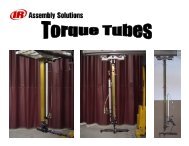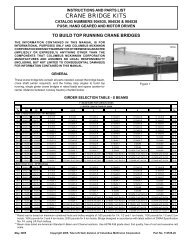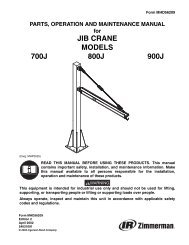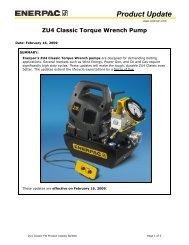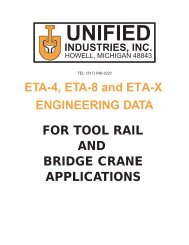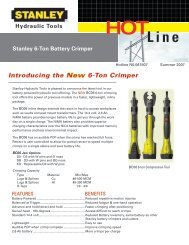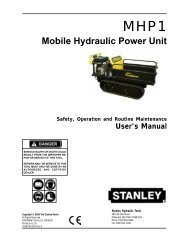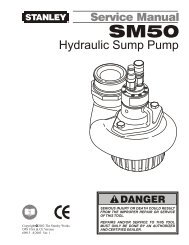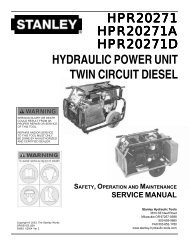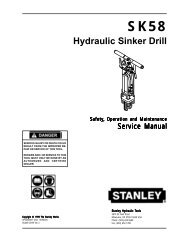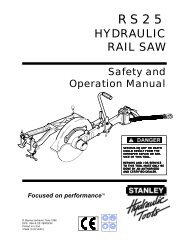HP18289M Service Manual.pdf - Tool-Smith
HP18289M Service Manual.pdf - Tool-Smith
HP18289M Service Manual.pdf - Tool-Smith
You also want an ePaper? Increase the reach of your titles
YUMPU automatically turns print PDFs into web optimized ePapers that Google loves.
GENERAL<br />
TESTING & TROUBLESHOOTING<br />
Tests and adjustments should be performed periodically to<br />
ensure the power unit is operating at maximum efficiency.<br />
Stanley Circuit Tester (Part Number 04182) is recommended.<br />
This tester can be used to isolate problems in<br />
both the engine and hydraulic system prior to any power<br />
unit disassembly.<br />
TESTING THE HYDRAULIC CIRCUIT<br />
The following tests can be performed to ensure that the<br />
hydraulic pump is supplying the correct flow and pressure<br />
and that the system relief valve is operating properly.<br />
During these tests, make sure the engine is warm<br />
and operating smoothly. If test results are not as specified,<br />
refer to the troubleshooting table given in this section for<br />
possible causes.<br />
TESTING THE 8 GPM CIRCUIT<br />
To test the circuit, proceed as follows:<br />
1. Set the Circuit Control Lever to the "OFF" position.<br />
2. Connect the Stanley Circuit Tester across two hose ends<br />
(where the tool would normally be connected).<br />
3. Fully open the tester restrictor valve (counter clockwise).<br />
4. Start the engine and allow it to run until warm.<br />
5. Pull the engine throttle control completely "OUT" so that<br />
the engine is running at full RPM.<br />
6. Move the Circuit Control Lever to the "ON" position.<br />
7. With the engine at high speed, the test flow gauge should<br />
read at least 8 gpm / 30 lpm.<br />
8. Slowly turn the restrictor valve clockwise while watching<br />
the pressure gauge. The flow rate should stay at<br />
8-9 gpm / 30-34 Ipm as the pressure gauge reaches 2100-<br />
2200 psi / 148-155 bar.<br />
9. At 2100-2200 psi/148-155 bar the relief valve should<br />
begin to open. The pressure at which the relief valve just<br />
begins to open is commonly referred to as the "cracking<br />
pressure". At the "cracking pressure", the flow rate should<br />
start to drop because the relief valve is allowing fluid to<br />
bypass to the hydraulic reservoir. The "cracking pressure" is<br />
preset at the factory and if it is not within the above range,<br />
the relief valve must be reset as follows:<br />
a. Access to the relief valve can be gained through the top of<br />
the power unit between the dash panel and top grille. If more<br />
room is required, remove the dash panel. Use a open end or<br />
box end wrench to remove the cap on the relief valve.<br />
b. Use an Allen wrench to adjust the relief valve. Turn<br />
clockwise to raise the pressure and counterclockwise to<br />
reduce the pressure.<br />
c. Replace the cap and test for 2100-2200 psi/148-155 bar<br />
as described above.<br />
d. Repeat the above test with the hoses and tester<br />
connected to the other circuit.<br />
14



